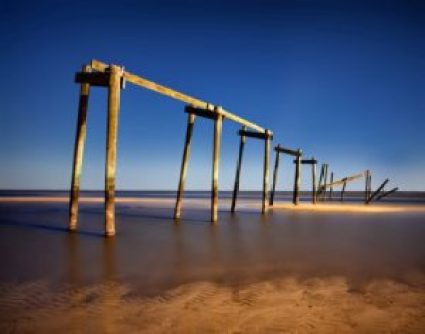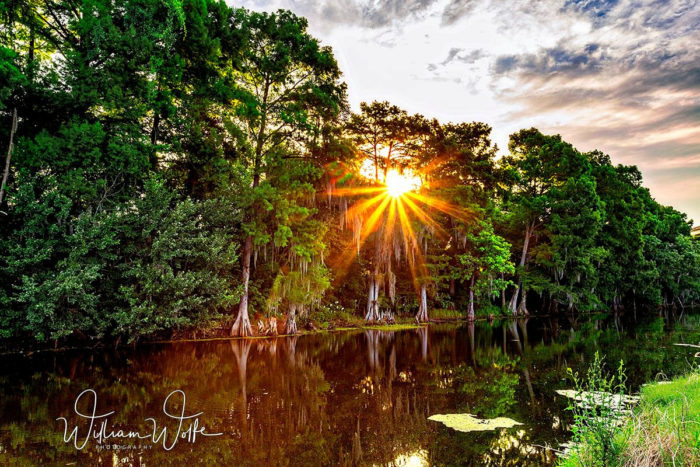Behind the Scenes:
An interview with photographer Bill Wolfe ~ ~
A fixture on the scale model contest circuit, Bill Wolfe is often seen lugging his camera around documenting the contestant’s entrees. He seems like a normal guy, but his photographic skills set him apart from the average photographer. Anybody who has a smart phone takes pictures. But few effectively capture the nuances of creations which are held together with Testors Cement the way Wolfe does.
There’s more. He’s had ten years’ experience as a wedding and portrait photographer, as well as shooting cityscapes. His magical landscapes draw you in and seem to whisper: “Come closer.”
Hub: You get incredible detail showing up in the photos of the plastic models that you take. How do you do it?
Bill: The secret to highly detailed model photos is, for me, a combination of lighting and equipment. That probably won’t sit well with people hoping they can get similar results with a camera phone. They will be able to soon, we’re just not quite there yet. I like to use a 50mm macro lens on my DSLR. This allows me to get in very close – often as close as an inch from the surface of the model. Getting in that close requires a lot of light being aimed at the proper spot on the model.
Hub: Do you have any tips on getting better shots of plastic models?
Bill: If the background is to be white, even more (brighter) light will be needed. This seems backwards, but it is the case. If incandescent lighting is used, often the white background will look yellowish in the final image. This will need to be taken into account with camera settings or corrected in software after the fact. As long as ‘white’ looks ‘white’ in the completed image, the colors of the model will be their most accurate.
Hub: You do a lot of landscapes and wildlife shots. What do you look for when shooting a subject?
Bill: With photography, it’s all about the lighting. When shooting landscape images, I like to go out before sunrise or after sunset, depending on the subject and where the sun will be at the time. I also like a water element to double the look of the sky. Living in S outh Louisiana, where the land is mostly flat, it can be quite a challenge to find points of interest.
outh Louisiana, where the land is mostly flat, it can be quite a challenge to find points of interest.
I didn’t really realize this until a recent trip to California where they have hills, mountains and valleys. Returning home, I was struck with just how flat this area is. There aren’t many things around to break the horizon. Even the city of New Orleans is comparatively small (in relation to a city like New York) and only offers one decent vantage point (which is from the West Bank on Algiers point – in my opinion). Perhaps that’s another reason that I’m drawn to water elements – at least there is some change in elevation to add some visual interest. Don’t get me wrong. There are some beautiful and unique scenes to photograph here in Louisiana. It can just become repetitive after years of shooting them.
Hub: Do you have a favorite subject to shoot?
Bill: I prefer to capture images that are not posed or planned but rather ‘found’. The images that I shoot can be described as literal, choosing to capture subjects as they naturally appear. I suppose landscapes would rank as one of my favorites. However, each discipline of photography requires a different skill set and I’m always open to expanding my experience.
To me, there has always been something special about sunrise and sunset. I love to catch those first rays of light of a new day, as well as the last gasp of light as day gives way to night. I watch the weather report each night. I use that information to decide if I’m going to get up the next day and go out to make some photographs. If the forecast is ‘fog and mostly cloudy’, I might take a chance and get up early.
Sometimes you get up hours before dawn, drive some distance in the dark and hope for the best. Sometimes the sunrise is a ‘dud’ and you’ve wasted time, gas and sleep. The light in my images is real. Sure, the photo has been ‘tweaked’ as all images are with some contrast and brightness and sharping, but the sky and the colors are just as they looked to my eye at the time.

Hub: What is it that sparked your interest in doing sometime more than the typical amateur photographer?
Bill: First, let me say that I think camera phones are great! It means that you always have a camera with you. Of course, there’s the old saying that “the best camera is the one that you have with you”. So, for that reason alone, they are really invaluable. My only issue with them for ‘serious’ photography is that (currently) the user has almost no control over the camera. So you end up with snapshots rather than photographs.
I think what drew me more into photography was the idea that, with knowledge, I would be the one controlling the camera instead of the other way around. My wife bought me my first real SLR camera (a Canon Rebel – 35mm film) for Father’s Day one year. I was a bit intimidated by all the knobs and settings and really curious as to what they meant and what they did. So, I took three semesters at Delgado (adult night classes). There was no degree or diploma, but I learned a lot.
When the class went into the dark room and we got to see an image appear on what looked like a normal sheet of paper, I was hooked! In fact, while digital is the medium of the times, I still have a fully functional dark room. Since those early days I’ve been motivated by what I suspect most photographers are – the ability to create an image, instead of just taking a picture.
Hub: You once mentioned that the human eye has more “shutter speeds” than a camera. Would you refresh my memory  on the context of that?
on the context of that?
Bill: I recall that conversation. I think what I was saying is that the human eye has about 21 stops of range. That’s why a person can see dark shadow detail even while standing out in a bright sunny place. For example, you can see what’s going on in a dark barn while standing outside on a bright day. Of course, that all depends on other factors like the position of the sun and so on, but in general, that’s the idea. I think the reason we were talking about it was because of the somewhat recent use of HDR photography by so many photographers.
Hub: What do you mean by “HDR”?
Bill: HDR (high dynamic range) photography is the technique of shooting multiple exposures of the same exact image with different light levels, usually one ‘normal’ exposure, one under exposed and one over exposed. HDR images can use these 3 or more (I’ve used as many as 9) images, combining them together to create a single photo with much greater range than what a single photo could ever capture. With a single photo, the photographer usually has a decision to make. “Do I want the sky properly exposed or do I want the land?” Or, “Do I want the person or the sky?” Even; “Do I want inside of the building or the outside of the building exposed properly?” With HDR imaging, you don’t have to decide, you can have both!
There are several books on the subject and multiple different software programs that will aid the HDR photographer. It’s really easy to take the final image too far and have the photo look unrealistic. However, with a little planning and  restraint, one can create some stunning images that will more closely resemble what was seen by the eye (with all its stops of exposure) while standing there!
restraint, one can create some stunning images that will more closely resemble what was seen by the eye (with all its stops of exposure) while standing there!
Many people frown on HDR imaging, but I’m a big fan of it. If done correctly, the viewer won’t even know that what they’re looking at is an HDR image. That’s really the idea. Sometimes it’s just fun to push the limits and go crazy with it! Why not? As long as the final image pleases the eye of its creator, the image was a success!
Hub: Do you have any future projects on the drawing board?
Bill: My goal in photographing New Orleans is to try to capture images without people or tourists – no small task in a city that truly never sleeps I’ve spent many hours in all types of weather conditions to make these images.
Having lived in what is often described as the Deep South for over 35 years, one can’t help but be influenced by its rich history. Not just in the New Orleans French Quarter, but all throughout South Louisiana. The cultures of past settlers have mixed and mingled over the generations into something that can only be explained as ‘Cajun’.
Taking photographs for the sake of taking them isn’t the goal however. The responsibility to document a place and time in a pleasing or artistic way is my desire. With future projects I intend to take this goal much further. I’ll do this by bringing attention, through photography, to unique subjects found almost exclusively in the deep South.
 Working in both digital and film formats, Bill still operates a functional darkroom and his love of print making, born in photography class, is still alive and well.
Working in both digital and film formats, Bill still operates a functional darkroom and his love of print making, born in photography class, is still alive and well.
Bill’s website is: www.williamwolfephotography.com
Bill’s YouTube Channel is: https://www.youtube.com/channel/UCjKp1jMd-PIOcKNeE7hXASw
Photos are copyrighted by Bill Wolfe and are used with his permission
Music: “Whisper” is composed, copyrighted, and recorded by Jeff Junker
